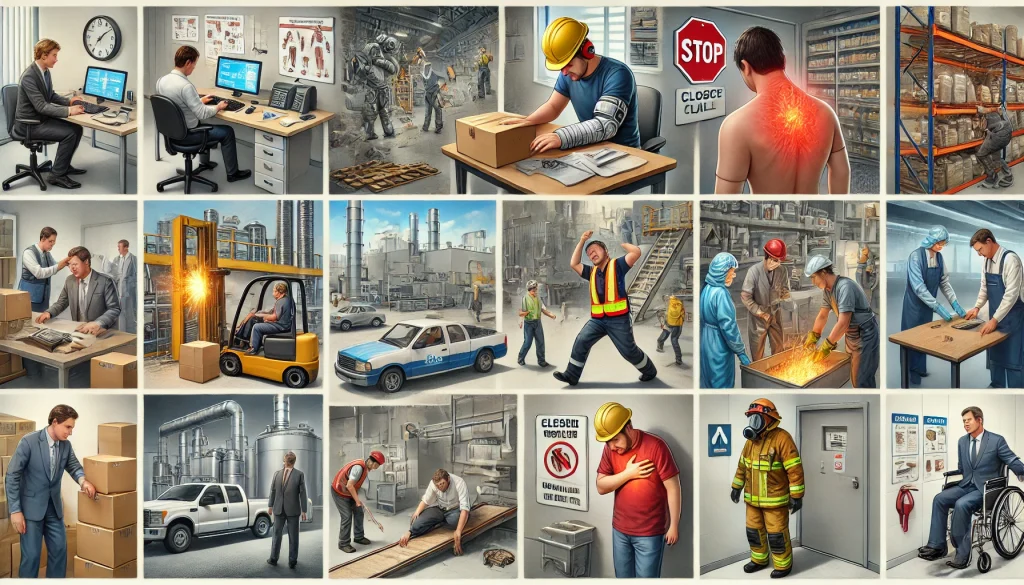Construction is one of the most hazardous industries in California, with workers facing daily risks such as heavy machinery, dangerous heights, and exposure to harmful materials. Injuries on construction sites can be severe, often resulting in significant medical expenses and time away from work. Fortunately, California workers’ compensation laws provide protections for injured construction workers, ensuring they have access to medical care and financial support.
This article explains the rights of construction workers under workers’ compensation laws, common injuries, and the steps to file a claim.
Common Construction Site Hazards and Injuries
Construction workers are exposed to a wide range of hazards that can lead to injuries or illnesses. Common risks include:
1. Falls from Heights
- Working on scaffolding, ladders, or roofs increases the risk of falls, which can result in serious injuries like fractures or traumatic brain injuries (TBIs).
2. Machinery Accidents
- Heavy machinery such as cranes, bulldozers, and forklifts can cause crush injuries or amputations if mishandled or poorly maintained.
3. Electrocution
- Contact with live wires, faulty equipment, or improper grounding can result in severe burns or fatal injuries.
4. Struck-By Accidents
- Workers are at risk of being struck by falling tools, materials, or equipment, causing head or body injuries.
5. Repetitive Motion Injuries
- Tasks involving repetitive motions, such as hammering or drilling, can lead to musculoskeletal disorders.
6. Exposure to Hazardous Materials
- Prolonged exposure to asbestos, silica dust, or toxic chemicals can cause respiratory illnesses or long-term health problems.
Are Construction Workers Covered by Workers’ Compensation in California?
Yes, all construction workers classified as employees are covered by workers’ compensation in California. State law requires employers to provide workers’ compensation insurance for all employees, including those in high-risk industries like construction.
Key Requirements for Coverage:
- Employee Classification:
Workers must be classified as employees, not independent contractors. - Work-Related Injury or Illness:
The injury must arise out of and occur in the course of employment.
Subcontractor and Independent Contractor Considerations:
- Subcontractors hired by a general contractor are typically covered under the contractor’s workers’ compensation policy.
- Independent contractors may not be eligible for benefits unless misclassified, in which case they may challenge their status to secure coverage.
Filing a Workers’ Compensation Claim for Construction Injuries
If you’ve been injured on a construction site, follow these steps to file a workers’ compensation claim:
1. Seek Immediate Medical Attention
Visit a healthcare provider for treatment. In emergencies, go to the nearest hospital, but for non-emergencies, use a provider within your employer’s medical network if required.
2. Report the Injury
Notify your supervisor or employer about the injury as soon as possible. California law requires workers to report injuries within 30 days of becoming aware of them.
3. Complete the DWC-1 Claim Form
Request the workers’ compensation claim form (DWC-1) from your employer, fill it out, and submit it to initiate the claims process.
4. Document the Incident
Gather evidence to support your claim, including:
- Photos of the injury site and hazards.
- Witness statements from coworkers or supervisors.
- Medical records detailing your diagnosis and treatment.
5. Follow Up with the Insurance Carrier
Stay in contact with the workers’ compensation insurance carrier to ensure your claim is processed and provide additional documentation if requested.
Benefits Available to Injured Construction Workers
If your claim is approved, you may be entitled to the following benefits under California workers’ compensation laws:
- Medical Care:
Full coverage for treatments, surgeries, medications, and rehabilitation. - Temporary Disability Benefits:
Partial wage replacement if you are unable to work temporarily. - Permanent Disability Benefits:
Compensation for long-term impairments resulting from the injury. - Supplemental Job Displacement Benefits (SJDB):
Vouchers for retraining or education if you cannot return to your previous role. - Death Benefits:
Financial support for dependents in the event of a fatal workplace injury.
Challenges in Construction Workers’ Compensation Claims
Construction injury claims often face unique challenges, including:
1. Proving Work-Relatedness
Employers or insurers may argue that the injury was caused by activities outside of work.
2. Classification Disputes
Workers misclassified as independent contractors may need to challenge their status to access benefits.
3. Third-Party Liability
If a third party, such as a manufacturer or subcontractor, contributed to the injury, workers may need to pursue additional legal action outside of workers’ compensation.
4. Delayed Claims
Complex construction site conditions and the involvement of multiple parties can slow the claims process.
How to Strengthen Your Construction Injury Claim
To improve your chances of a successful claim, consider the following:
- Act Quickly:
Report your injury and file your claim as soon as possible to avoid disputes over timing. - Gather Evidence:
Collect detailed documentation of the incident, including photos, witness statements, and medical records. - Seek Medical Expertise:
Work with doctors familiar with workplace injuries to ensure accurate diagnoses and treatment plans. - Consult an Attorney:
An experienced workers’ compensation attorney can help navigate disputes, gather evidence, and advocate for your rights.
How an Attorney Can Help Construction Workers
An experienced attorney can provide critical support for injured construction workers by:
- Ensuring proper classification as an employee.
- Proving the work-related nature of the injury.
- Addressing disputes with insurers or employers.
- Pursuing third-party claims if another party’s negligence contributed to the injury.
- Representing you in appeals if your claim is denied.
Conclusion
Construction workers face unique risks, but California workers’ compensation laws provide essential protections for those injured on the job. Understanding your rights and following the proper steps can help you secure the benefits you need to recover.
If you’re dealing with a construction site injury or a dispute over your claim, consulting an experienced workers’ compensation attorney can provide the guidance and advocacy needed to achieve a favorable outcome.


